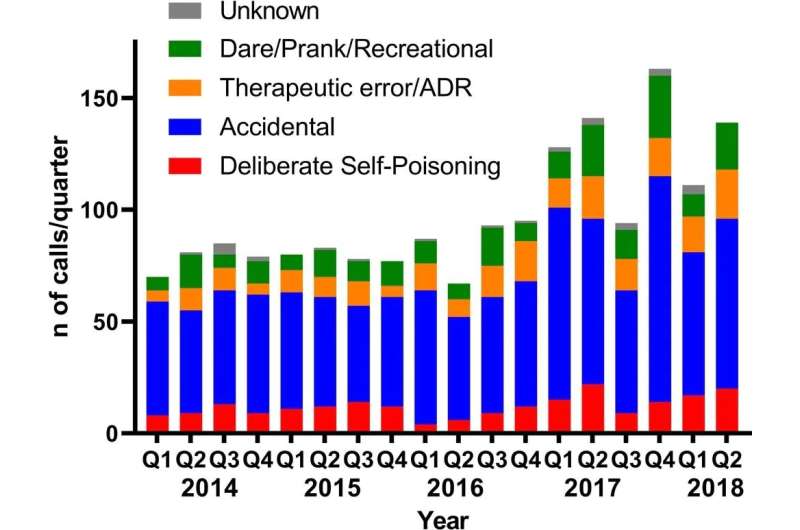New study reveals poisoning exposures in Australian schools

New research from the University of Sydney has found poisoning exposures in children and adolescents while at school are relatively common and appear to be increasing, highlighting the need for more robust prevention measures.
The authors state that by focusing on improved safety strategies, the incidence of poisonings in schools could decrease.
Published today in the Archives of Disease in Childhood, it is the most up-to date study to investigate poisonings in schools in New South Wales, Australian Capital Territory and Tasmania, with data revealing the types of exposures and substances involved.
The researchers studied cases reported to the New South Wales Poisons Information Centre (NSWPIC) over a 4 and-a-half-year period (January 2014 to June 2018). NSWPIC is Australia's largest Poisons Information Centre, taking 50 percent of the nation's poisoning calls.
Injury and poisoning are major causes of hospitalization and death in children globally. Poisoning is the third leading source of hospitalized childhood injury in Australia and is largely preventable.
"The study found 1751 calls relating to exposures at school made to the Poisons Information Centre, with 61 percent concerning accidental exposures, 12 percent concerning deliberate self-poisonings and 12 percent from medication dosing errors," said senior author Dr. Rose Cairns from Sydney School of Pharmacy, in the Faculty of Medicine and Health, and senior poisons specialist at the NSW Poisons Information Centre.
"Most self-poisoning exposures were from over-the-counter products such as paracetamol, and most accidental exposures occurred from stings and bites, exposures to plants and in science class.
"Poisoning exposures at school appear to be increasing, with 81 calls per quarter in 2014-2016, and 129 calls per quarter in 2017-2018.
"Children are at risk of different types of poisoning depending on their age and developmental stage. Younger children are at risk of accidental exposures, while adolescents are at risk of self-harm poisonings. Deliberate self-poisoning (self-harm exposures/overdose) is increasing in children and adolescents in Australia, and elsewhere," Dr. Cairns said.
Study findings
- The median age was 12 years old and exposure peaked in children 14 years
- 55 percent of cases were male
- Deliberate self-poisoning was predominantly reported in girls (79 percent)
- More than 25 percent of poisoning cases were hospitalized, with deliberate self-poisoning exposures being the most common reason (92 percent), recreational exposures (57 percent) and other intentional exposures (33 percent)
- Accidental exposures (15 percent) and medication errors (11 percent) had low hospital referral rates
- Over-the-counter medicines such as paracetamol and ibuprofen were most commonly taken in self-poisoning incidents
- Medication errors occurring at school accounted for nearly 12 percent of cases with the most common medications involved being methylphenidate and clonidine (ADHD medications), and paracetamol. Where recorded, 150 cases involved a dosing error with a medication prescribed for the child involved, while 40 cases were prescription medication administered to the wrong child
- Science class poisoning exposures accounted for 19 percent of accidental exposures, and a range of substances were involved. Copper sulfate was responsible for approximately one-quarter of all science class exposures, of which 45 percent resulted in hospitalization. Most science class exposures were accidental.
- Accidental exposures, dares, pranks and recreational exposures occurred more frequently in boys
- Poisons calls were not just about medicines, but included everything from insect bites, mushrooms and hand sanitiser, to glow sticks, soap and disinfectant.
Strategies needed to stop preventable poison exposures
"Many of these poison exposures were likely preventable, so we need to focus on strategies for prevention and school-based initiatives and programs to make the school environment safer for students," said Dr. Cairns.
"A better understanding of reasons for poisonings, and circumstances surrounding exposures, is key to guiding public health strategies for poisoning prevention.
"For accidental poisoning exposures schools could undertake a risk assessment of common chemistry experiments and reinforce the use of personal protective equipment in class. This includes the provision of well-fitting goggles to prevent eye exposures.
"In the case of deliberate self-poisonings, schools could look to increase teacher training for identifying and responding to mental health problems, anti-bullying strategies, more school counselors, regulation of social media use, and mental health first aid training for teachers. The increased funding for school counselors and psychologists announced in September is a step in the right direction.
"Despite there being policies and procedures regarding medication handling in Australian schools, medication administration errors were common over the study period. While low risk, our study highlights the importance of medication skills training by school staff to ensure correct administration of medications to students. Some medicines are self-administered by students during school time, so increased counseling by prescribers may also help, or consideration of dosing regimens that avoid medication during school hours.
"This is particularly important as Australian studies have found that the prescribing of medicines in children and adolescents, particularly of psychotropics, has increased substantially and it was these medicines where the dosing errors occurred most frequently.
"Poisonings can occur in any setting, including at home and at school. While we often focus on poisoning prevention initiatives to improve safety in the home, we need to recognize that children spend a large portion of their waking hours at school, so it's important to consider simple ways we can decrease poisoning exposures in this setting."
More information: Jennifer Ly et al, Paediatric poisoning exposures in schools: reports to Australia's largest poisons centre, Archives of Disease in Childhood (2020). DOI: 10.1136/archdischild-2020-319919

















